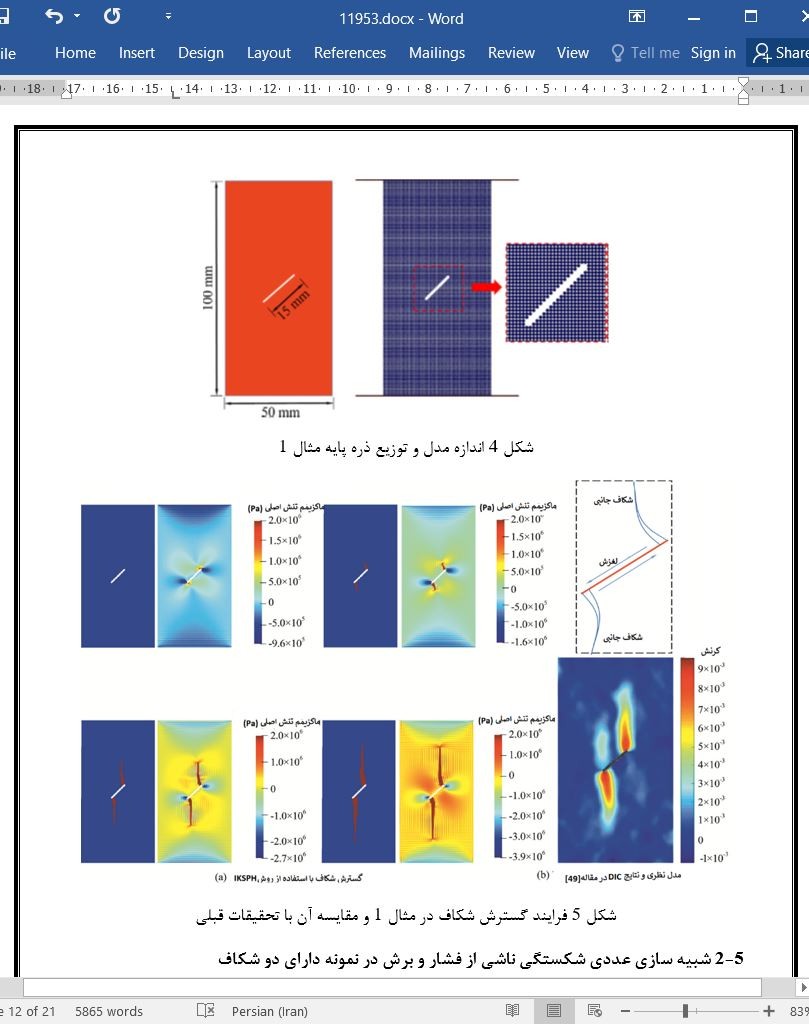
مدل پیشرفته ای از روش هیدرودینامیک ذرات هموار برای شبیه سازی گسترش ترک در مکانیک سنگ
چکیده
شبیه سازی فرایند گسترش ترک در مهندسی سنگ نه نتها موضوع داغ مورد بررسی توسط محققان بوده بلکه یک چالش مهم است. با در نظر داشتن این پیش زمینه، یک روش عددی به نام کرنل پیشرفته هیدرودینامیک ذرات هموار (IKSPH) معرفی شد. با بهبود تابع کرنل در روش هیدرودینامیک ذرات هموار (SPH) مرسوم، ویژگی های شکنندگی (تردی) ذرات اصلی شناخته می شود. روش جستجوی دامنه ذره (PDSM) نیز برای ایجاد شبکه های پیچیده شکاف استفاده شد. سه مثال عددی برای اعتبارسنجی راندمان روش های IKSPH و PDSM آنالیز شدند که توانستند مورفولوژی شکاف جانبی را به درستی مشخص کنند و قوانین مربوط به به هم پیوستن شکاف ها را در مقایسه با پژوهش های عددی و تجربی پیشین نشان دهند. نهایتا یک مدل سنگ شیبدار دارای درزهای پیچیده بصورت عددی شبیه سازی شد و فرایند گسیختگی پیشرونده آن مشخص شد که نشان داد روش IKSPH را می توان به خوبی برای مهندسی مکانیک سنگ استفاده کرد. نتایج این تحقیق نشان داد که روش IKSPH دشواری های برنامه نویسی را کاهش می دهد و از کجی (اعوجاج) خطوط مش بندی جلوگیری می کند که می تواند مرجعی برای کاربرد IKSPH در مهندسی مکانیک سنگ و درک مکانیزم ترک برداشتن سنگ باشد.
1-مقدمه
سنگ یک ماده غیرمتناجس است که دارای شمار زیادی از نقص های ذاتی با استحکام نسبتا پایین است. این نقص ها شامل گسل ها، شکاف ها، درزها، سوراخ ها، لایه های درونی و غیره است که باعث می شود سنگ ویژگی های نظیر ناهمگنی، خطی نبودن و ناپیوستگی قوی داشته باشد [1]. علاوه بر این، تحت شرایط جفت شدگی پیچیده چند میدانی [2]، ساختار سنگ ممکن است بدلیل وجود این نواقص از هم شکسته شود. بنابراین چگونگی توصیف دقیق شاخص های ناپیوستگی توده های سنگ یکی از چالش های سخت سالیان اخیر بوده است.
6- نتیجه گیری ها
1) در این مقاله یک روش عددی بنام روش کرنل پیشرفته هیدرودینامیک ذرات هموار (IKSPH) که هدف آن مدلسازی ترک شکننده موجود در توده های سنگی است پیشنهاد شد. در مقایسه با پژوهش های پیشین، هیچ نیازی به کاهش سفتی نقطه پایه یا نقشه برداری تنش به تنش پیوستگی بین ذرات پایه مختلف نیست که این کار باعث شده تا دشواری برنامه نویسی کمتر شود. در عین حال، روش جستجوی دامنه ذره (PDSM) نیز برای ایجاد شبکه های ترک پیچیده استفاده شد.
Abstract
The simulation of crack propagation processes in rock engineering has been not only a research hot spot among scholars but also a challenge. Based on this background, a new numerical method named improved kernel of smoothed particle hydrodynamics (IKSPH) has been put forward. By improving the kernel function in the traditional smoothed particle hydrodynamics (SPH) method, the brittle fracture characteristics of the base particles are realized. The particle domain searching method (PDSM) has also been put forward to generate the arbitrary complex fissure networks. Three numerical examples are analyzed to validate the efficiency of IKSPH and PDSM, which can correctly reveal the morphology of wing crack and the laws of crack coalescence compared with previous experimental and numerical studies. Finally, a rock slope model with complex joints is numerically simulated and the progressive failure processes are exhibited, which indicates that the IKSPH method can be well applied to rock mechanics engineering. The research results showed that IKSPH method reduces the programming difficulties and avoids the traditional grid distortion, which can provide some references for the application of IKSPH to rock mechanics engineering and the understanding of rock fracture mechanisms.
1. Introduction
Rock is a typical anisotropic material, which contains large amounts of inherent defects with relatively lower strength. These defects include faults, fissures, joints, holes, interlayers and so on, which makes rock exhibit the characteristics of heterogeneity, non-linearity, and strong discontinuity [1]. Furthermore, under complex multi-field coupling conditions [2], the rock structures may fail due to these defects. Therefore, how to correctly describe the discontinuous characteristics of rock masses has been a hot but difficult problem in recent years.
6. Conclusions
(1) A new numerical method named improved kernel of smoothed particle hydrodynamics (IKSPH), which is aimed at modeling the brittle fracture of rock masses, has been proposed in this paper. Compared with previous studies, there is no need to reduce the stiffness of the base point or map the stress to the stress bond between different base particles, which has reduced programming difficulties. Meanwhile, the particle domain searching method (PDSM) has also been put forward to generate complex fissure networks.
چکیده
1-مقدمه
2- IKSPH پایه
1-2 معادلات حاکم
2-2 معادله مشخصه
3-2 ادغام زمان
4-2 قوانین انتگرال گیری کوادراتور
3- پردازش ترک در روش IKSPH
1-3 معیارهای ترک
2-3 روش جستجوی دامنه ذره (PDSM)
4- پردازش مرز
5- مثال ها و بحث
1-5 شبیه سازی عددی فشردگی و شکست برشی با یک شکاف تنها
2-5 شبیه سازی عددی شکستگی ناشی از فشار و برش در نمونه دارای دو شکاف
5-3 شبیه سازی عددی فشردگی و شکاف برشی با داشتن چندین شکاف
4-5 شبیه سازی عددی گسیختگی پیش رونده یک شیب سنگی شکاف دار
5-5 آنالیز هزینه محاسباتی
6- نتیجه گیری ها
منابع
Abstract
1. Introduction
2. Basic IKSPH
2.1. Governing equations
2.2. Constitutive equation
2.3. Time integration
2.4. Quadrature rules
3. Fracture treatments in IKSPH
3.1. Fracture criteria
3.2. Particle domain searching method (PDSM)
4. Boundary treatment
5. Examples and discussions
5.1. Numerical simulation of compression and shear failure with one single crack
5.2. Numerical simulation of compression and shear failure with two cracks
5.3. Numerical simulation of compression and shear failure with multiple cracks
5.4. Numerical simulation of progressive failure of a typical jointed rock slope
5.5. Computational cost analysis
6. Conclusions
Acknowledgements
References
- ترجمه فارسی مقاله با فرمت ورد (word) با قابلیت ویرایش، بدون آرم سایت ای ترجمه
- ترجمه فارسی مقاله با فرمت pdf، بدون آرم سایت ای ترجمه



